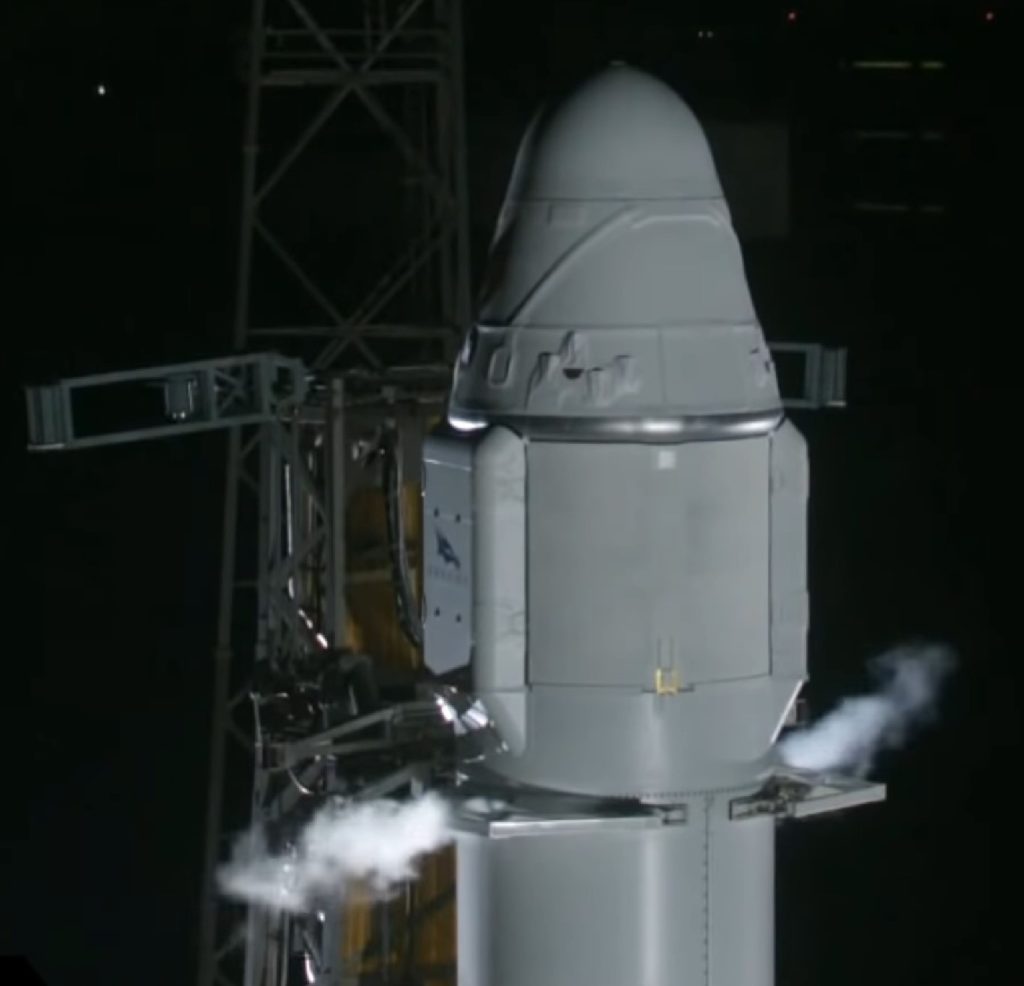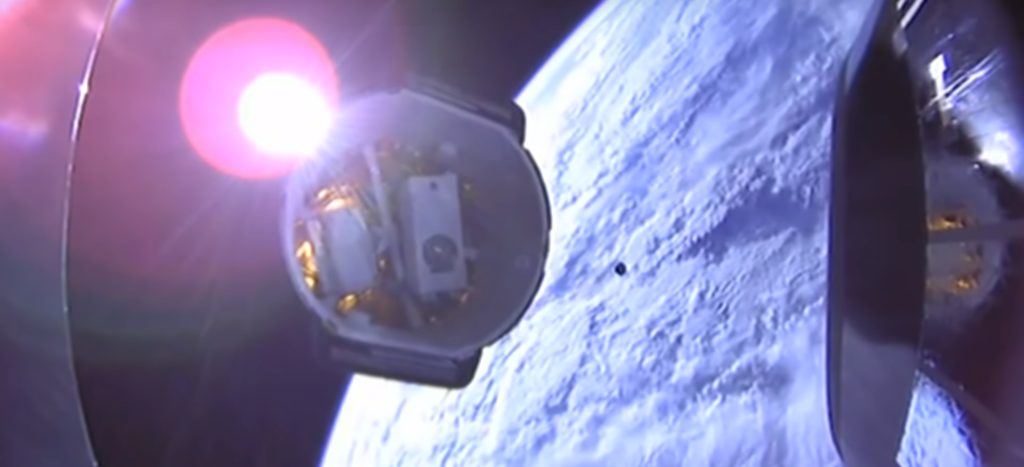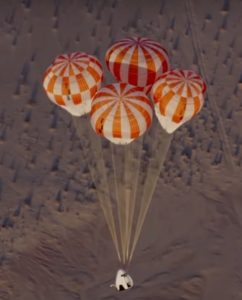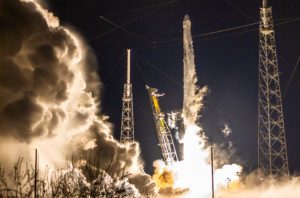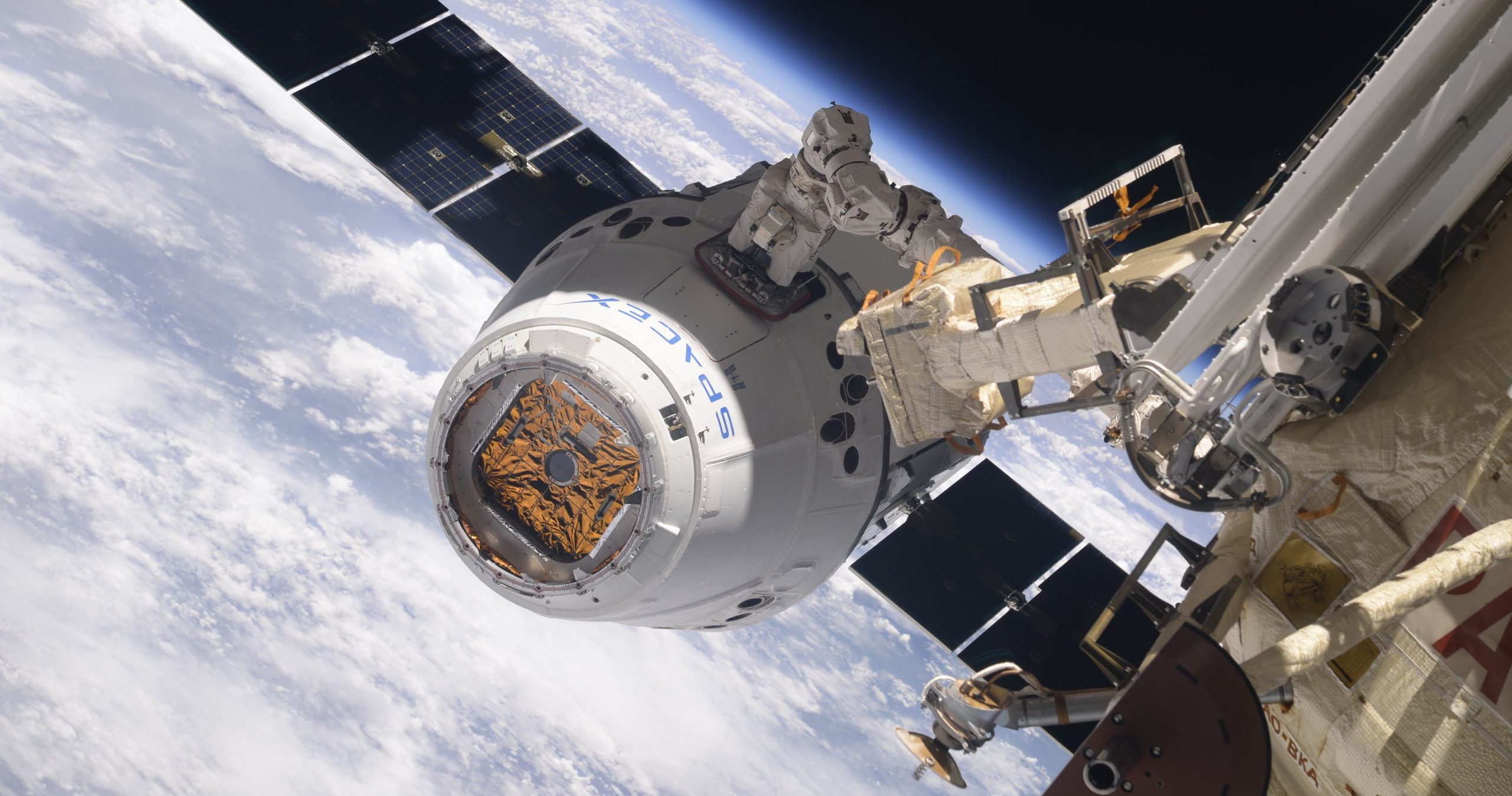
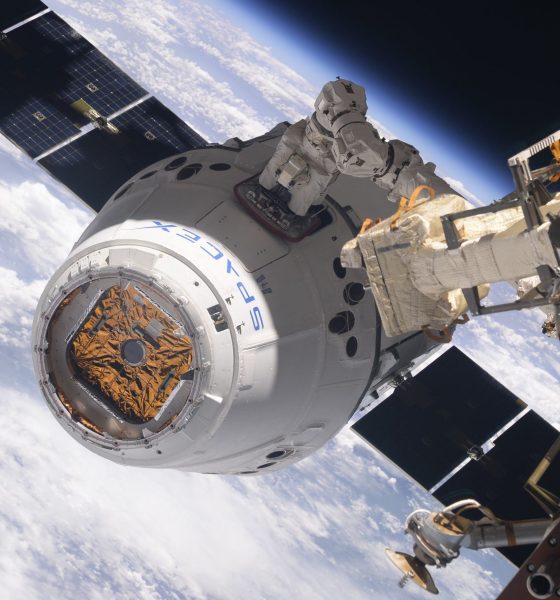
News
SpaceX Dragon spacecraft heads to ISS as crewed version preps for debut
SpaceX’s third flight-proven Cargo Dragon spacecraft has arrived in orbit and is currently making its way uphill to the International Space Station for the 15th SpaceX resupply, scheduled for arrival around 7 am EDT July 2nd. Meanwhile, the company’s new Crew Dragon is undergoing its own earthbound trials, split between an artificial vacuum chamber and parachute drop tests over the California desert.
Following a twilight launch that brought to a spectacular close an era of older, less-reusable Falcon 9 rockets, the Cargo Dragon capsule trunk full of several tons of supplies and scientific instruments were placed into a parking orbit roughly 200 miles above Earth’s surface, trailed by a mesmerizing rainbow plume created by Falcon 9’s first and second stage over their nine-minute journey.
- CRS-15 minutes before an early July 29 launch. (SpaceX)
- Nine minutes after launch, Falcon 9’s upper stage shut off its main engine and Cargo Dragon detached. (SpaceX)
After arriving in orbit, Crew Dragon separated from Falcon 9’s second stage and officially commenced its second orbital mission roughly 25 months after its first, CRS-9 in July 2016. Alongside the three that have now flown successfully, all five of SpaceX’s remaining Commercial Resupply Services-1 (CRS-1) missions will be conducted with flight-proven Dragon spacecraft, two or three of which will see the already-reused capsules fly a third time before being officially retired.
After SpaceX’s first CRS contract comes to an end, currently scheduled for early 2020 with the CRS-20 mission, the upgraded Dragon 2 will take over all future cargo launches. Dragon 2’s cargo configuration is expected to be a slightly different version of the Crew Dragon capsule and trunk, scheduled to debut as early as late 2018, but the specifics are still somewhat hazy. Most probably, recovered Crew Dragon capsules – unlikely to ever been certified to fly NASA astronauts – will instead be refurbished after their first orbital missions, modified slightly to meet the cargo requirements, and then use to complete SpaceX’s CRS-2 contract alongside their crew transport missions.
At Naval Air Facility El Centro in Southern California, SpaceX recently completed its 16th test of Crew Dragon’s parachute system—verifying the system’s ability to slow Crew Dragon and ensure a safe landing in the unlikely event of a low altitude abort. https://t.co/OOQnAtNXJ3 pic.twitter.com/kFX7Qth3AK
— SpaceX (@SpaceX) June 26, 2018
While its predecessors continue to grow SpaceX’s experience in orbit, the Crew Dragon program is making its own impressive progress towards the first uncrewed and crewed launch debuts in late 2018 and early 2019. DM-1, the capsule tasked with that first uncrewed demonstration, is likely nearing the end of a suite of tests inside NASA’s huge Plum Brook vacuum chamber facilities, ensuring that the brand-new spacecraft behaves as expected in the extreme environment of space. If successful, the capsule will be sent on its way to Cape Canaveral, Florida to begin true prelight preparations for the first time ever, while its trunk – an expendable structure installed at the base of the craft with solar arrays, radiators, and bays for unpressurized cargo – will be sent back to the Hawthorne, CA factory to be outfitted with flight hardware, after which it will ship to Florida one to two months after the capsule arrives.
- Crew Dragon parachute tests are likely to continue into the summer to ensure NASA certification in time for DM-1. (SpaceX)
- Falcon 9 B1045 and it’s flight-proven Cargo Dragon head skyward, marking the end of last-gen SpaceX Falcon 9 launches. (Tom Cross)
- CRS-15’s ‘jellyfish’ plume glowed as Falcon 9 flew above the terminator into the morning sun. (Tom Cross)
Meanwhile, the CRS-15 Dragon capsule currently orbiting Earth will dock with the International Space Station early Monday morning and is scheduled to depart, reenter, and return to Hawthorne, CA for Flight 3 refurbishment in early August, at which point the DM-1 Crew Dragon ought to have arrived in Florida. Aside from Dragon, SpaceX has three new Falcon 9 Block 5 launches scheduled between July 20 and August 2, the boosters of which will all be recovered aboard SpaceX’s fleet of drone ships
Follow us for live updates, peeks behind the scenes, and photos from Teslarati’s East and West Coast photographers.
Teslarati – Instagram – Twitter
Tom Cross – Twitter
Pauline Acalin – Twitter
Eric Ralph – Twitter

News
Tesla FSD (Supervised) v14.2.2 starts rolling out
The update focuses on smoother real-world performance, better obstacle awareness, and precise end-of-trip routing, among other improvements.

Tesla has started rolling out Full Self-Driving (Supervised) v14.2.2, bringing further refinements to its most advanced driver-assist system. The new FSD update focuses on smoother real-world performance, better obstacle awareness, and precise end-of-trip routing, among other improvements.
Key FSD v14.2.2 improvements
As noted by Not a Tesla App, FSD v14.2.2 upgrades the vision encoder neural network with higher resolution features, enhancing detection of emergency vehicles, road obstacles, and human gestures. New Arrival Options let users select preferred drop-off styles, such as Parking Lot, Street, Driveway, Parking Garage, or Curbside, with the navigation pin automatically adjusting to the user’s ideal spot for precision.
Other additions include pulling over for emergency vehicles, real-time vision-based detours for blocked roads, improved gate and debris handling, and extreme Speed Profiles for customized driving styles. Reliability gains cover fault recovery, residue alerts on the windshield, and automatic narrow-field camera washing for new 2026 Model Y units.
FSD v14.2.2 also boosts unprotected turns, lane changes, cut-ins, and school bus scenarios, among other things. Tesla also noted that users’ FSD statistics will be saved under Controls > Autopilot, which should help drivers easily view how much they are using FSD in their daily drives.
Key FSD v14.2.2 release notes
Full Self-Driving (Supervised) v14.2.2 includes:
- Upgraded the neural network vision encoder, leveraging higher resolution features to further improve scenarios like handling emergency vehicles, obstacles on the road, and human gestures.
- Added Arrival Options for you to select where FSD should park: in a Parking Lot, on the Street, in a Driveway, in a Parking Garage, or at the Curbside.
- Added handling to pull over or yield for emergency vehicles (e.g. police cars, fire trucks, ambulances).
- Added navigation and routing into the vision-based neural network for real-time handling of blocked roads and detours.
- Added additional Speed Profile to further customize driving style preference.
- Improved handling for static and dynamic gates.
- Improved offsetting for road debris (e.g. tires, tree branches, boxes).
- Improve handling of several scenarios, including unprotected turns, lane changes, vehicle cut-ins, and school buses.
- Improved FSD’s ability to manage system faults and recover smoothly from degraded operation for enhanced reliability.
- Added alerting for residue build-up on interior windshield that may impact front camera visibility. If affected, visit Service for cleaning!
- Added automatic narrow field washing to provide rapid and efficient front camera self-cleaning, and optimize aerodynamics wash at higher vehicle speed.
- Camera visibility can lead to increased attention monitoring sensitivity.
Upcoming Improvements:
- Overall smoothness and sentience.
- Parking spot selection and parking quality.
News
Tesla is not sparing any expense in ensuring the Cybercab is safe
Images shared by the longtime watcher showed 16 Cybercab prototypes parked near Giga Texas’ dedicated crash test facility.

The Tesla Cybercab could very well be the safest taxi on the road when it is released and deployed for public use. This was, at least, hinted at by the intensive safety tests that Tesla seems to be putting the autonomous two-seater through at its Giga Texas crash test facility.
Intensive crash tests
As per recent images from longtime Giga Texas watcher and drone operator Joe Tegtmeyer, Tesla seems to be very busy crash testing Cybercab units. Images shared by the longtime watcher showed 16 Cybercab prototypes parked near Giga Texas’ dedicated crash test facility just before the holidays.
Tegtmeyer’s aerial photos showed the prototypes clustered outside the factory’s testing building. Some uncovered Cybercabs showed notable damage and one even had its airbags engaged. With Cybercab production expected to start in about 130 days, it appears that Tesla is very busy ensuring that its autonomous two-seater ends up becoming the safest taxi on public roads.
Prioritizing safety
With no human driver controls, the Cybercab demands exceptional active and passive safety systems to protect occupants in any scenario. Considering Tesla’s reputation, it is then understandable that the company seems to be sparing no expense in ensuring that the Cybercab is as safe as possible.
Tesla’s focus on safety was recently highlighted when the Cybertruck achieved a Top Safety Pick+ rating from the Insurance Institute for Highway Safety (IIHS). This was a notable victory for the Cybertruck as critics have long claimed that the vehicle will be one of, if not the, most unsafe truck on the road due to its appearance. The vehicle’s Top Safety Pick+ rating, if any, simply proved that Tesla never neglects to make its cars as safe as possible, and that definitely includes the Cybercab.
Elon Musk
Tesla’s Elon Musk gives timeframe for FSD’s release in UAE
Provided that Musk’s timeframe proves accurate, FSD would be able to start saturating the Middle East, starting with the UAE, next year.

Tesla CEO Elon Musk stated on Monday that Full Self-Driving (Supervised) could launch in the United Arab Emirates (UAE) as soon as January 2026.
Provided that Musk’s timeframe proves accurate, FSD would be able to start saturating the Middle East, starting with the UAE, next year.
Musk’s estimate
In a post on X, UAE-based political analyst Ahmed Sharif Al Amiri asked Musk when FSD would arrive in the country, quoting an earlier post where the CEO encouraged users to try out FSD for themselves. Musk responded directly to the analyst’s inquiry.
“Hopefully, next month,” Musk wrote. The exchange attracted a lot of attention, with numerous X users sharing their excitement at the idea of FSD being brought to a new country. FSD (Supervised), after all, would likely allow hands-off highway driving, urban navigation, and parking under driver oversight in traffic-heavy cities such as Dubai and Abu Dhabi.
Musk’s comments about FSD’s arrival in the UAE were posted following his visit to the Middle Eastern country. Over the weekend, images were shared online of Musk meeting with UAE Defense Minister, Deputy Prime Minister, and Dubai Crown Prince HH Sheikh Hamdan bin Mohammed. Musk also posted a supportive message about the country, posting “UAE rocks!” on X.
FSD recognition
FSD has been getting quite a lot of support from foreign media outlets. FSD (Supervised) earned high marks from Germany’s largest car magazine, Auto Bild, during a test in Berlin’s challenging urban environment. The demonstration highlighted the system’s ability to handle dense traffic, construction sites, pedestrian crossings, and narrow streets with smooth, confident decision-making.
Journalist Robin Hornig was particularly struck by FSD’s superior perception and tireless attention, stating: “Tesla FSD Supervised sees more than I do. It doesn’t get distracted and never gets tired. I like to think I’m a good driver, but I can’t match this system’s all-around vision. It’s at its best when both work together: my experience and the Tesla’s constant attention.” Only one intervention was needed when the system misread a route, showcasing its maturity while relying on vision-only sensors and over-the-air learning.
